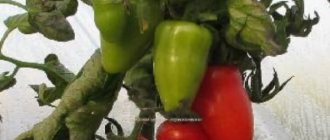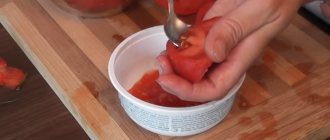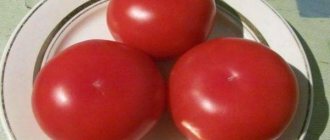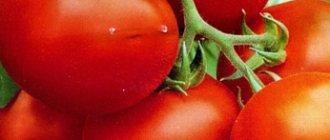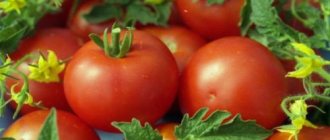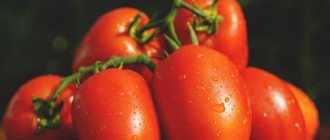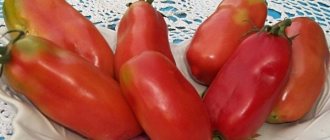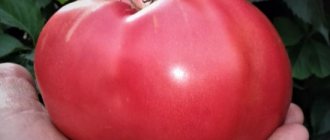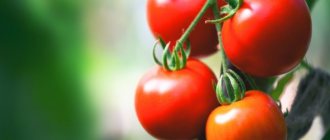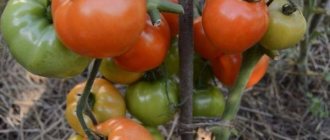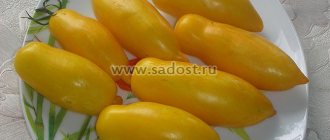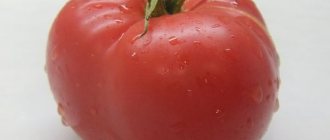Tomato Max is one of the innovative and promising tomato varieties. This variety belongs to determinant non-standard varieties.
The popularity of tomatoes provokes breeders to invent new varieties, more improved and stronger. The Max variety is exactly this variety. The abundance of tomato varieties leads to the fact that consumer tastes are becoming more and more demanding; an ordinary tomato with a very mediocre taste will no longer surprise anyone.
At the present stage of our lives, tomatoes should combine high yield, excellent taste, and ease of care. It is Max who meets all such characteristics.
Characteristics and description of the Max variety
Max tomatoes have been known to gardeners since 1998, when they were introduced by Poisk-Plus JSC. They are equally suitable for growing both in open beds and in greenhouse conditions. It is recommended to place tomatoes in closed ground if you want to “squeeze” maximum yield from the crop.
Semi-spreading bushes are distinguished by medium-level branching and foliage. Max belongs to varieties with limited stem growth and does not exceed 70 cm in height. The leaves are light green, slightly corrugated.
The plant forms simple intermediate inflorescences - the first is formed above the 6-7th leaf, the next - after 1-2 leaves.
4-5 ovaries are formed on each inflorescence. The largest fruits grow on the middle part of the stem.
Flat-round, bright red tomatoes ripen together. There are at least 4 seed chambers in a tomato. Behind the dense skin, which partly provides the vegetables with good shelf life, lies a fleshy, juicy pulp with high taste qualities. The characteristic tomato taste is dominated by sweetness and barely noticeable sourness.
In the photo and in reality the fruits look beautiful.
The Max variety is distinguished by its culinary versatility - these tomatoes can be used for making salads, homemade ketchup, juice and canning.
Description and characteristics of the variety
The variety is determinate, the height of the bush is 60-70 cm. The ripening period is early - 100-105 days from germination. The plants are semi-spreading, low-growing, with a strong stem. The foliage is medium, the tomato leaf is thick, dark green in color. The inflorescences are simple, bearing 3-5 fruits. Brushes are laid regularly, starting from 5-6 sheets and alternating through 1-2 sheets.
Tomatoes are suitable for canning, processing into paste, juice, and ketchup. Good fresh, in salads and slices.
The tomato is flat-round, smooth, with slight ribbing in the area of the stalk. In the lower and upper parts of the stem the fruits are smaller, and in the middle they are larger - up to 120 grams. The skin is durable, rich red in color. The pulp is juicy, elastic, fleshy. Taste qualities are high, the tomatoes are sweet, aromatic, with a pleasant sourness.
Features of cultivation and care
The dates for sowing seeds should be planned taking into account the fact that Max is planted in open ground at the end of May - early June, in closed ground - in early May.
In the northern regions and the middle zone, for the full development of the plant, it is recommended to sow seeds for seedlings 60 days before the expected date of planting them in open beds or in a greenhouse; in the southern regions, this period can be reduced to 55 days.
To plant Max tomatoes, it is recommended to set aside an area where carrots, zucchini, cucumbers, cabbage, and salads grew last year.
The cultivar is not picky about soil, but feels best on sandy loam soil.
For full development, it is recommended to plant no more than 6 bushes per 1 square meter.
Max loves sunlight, but in principle, he grows well and bears fruit even in conditions where daylight hours last for 8.5-9 hours. Experienced gardeners advise, if there is a lack of sun, to increase illumination to 10 hours a day using LED lamps.
Tomato Max belongs to that convenient group that does not require tying or pinching for care.
When growing a variety in a greenhouse, you should maintain the air temperature in it no higher than 23-25 ° C, and also ventilate it regularly.
Both in the ground and in closed ground, it is important to weed weeds in a timely manner and loosen the soil after each watering. In not very hot summers, it is enough to water the tomatoes 2-3 times a week.
Features of planting and growing
Those who planted this variety of tomato testify to its excellent fruiting in the open ground and in the greenhouse.
Landing
Like most of its relatives, the Max tomato is recommended for growing through seedlings. To do this, you must first plant the seeds. Sow the seeds in separate containers to a depth of 0.5 cm in moist, loose soil. This is done mainly in the second half of March. To speed up the seed germination process, containers can be covered with glass.
Next, you need to put the containers in a warm place and wait for germination. It is necessary to periodically moisten the soil; if desired, it can be fertilized. When the seeds have sprouted and 1-2 true leaves have appeared on them, the seedlings dive into separate pots. This usually happens 18-23 days after planting the seeds. Picked plants also need to be periodically moistened and hardened.
In order for the seedlings to harden and become strong, you need to periodically take them out onto the balcony or outside. At first this is done for an hour or two and gradually increases the time she spends in the fresh air to a whole day.
Important to remember. It is worth leaving seedlings outdoors for a long time only when the threat of night frosts has already passed. Otherwise, the plant may freeze and die.
When the frost has already passed and the seedlings have passed all the necessary stages of hardening, they can be planted in open ground. As a rule, this happens when the seedlings already have 6-7 true leaves.
The plant is planted in open soil in late May - early June. You can safely plant seedlings in the greenhouse in early May.
It is best to dig the holes in a checkerboard pattern at a distance of 50-60 cm from each other. The holes must be watered and organic natural fertilizer added to them. You can do without fertilizer, but with it the plant will grow faster and begin to bear fruit.
See also
Description of the tomato variety Shaggy Kate, its characteristics and yieldRead
Diseases and pests of the variety
The Max tomato variety is highly resistant to diseases and pests. According to some gardeners, these tomatoes are still susceptible to fungal infections if the rules of agricultural cultivation are not followed.
Black leg may appear on tomato seedlings almost immediately after germination if the seeds and soil have not been treated. The impetus for development is severe waterlogging of the substrate. Symptoms of the disease: blackening and drying of the root part of the stem, the appearance of a scattering of dark spots on the leaves. Seedlings may die.
To prevent blackleg, preventive measures are important - plants should not be thickened when planting and should not be over-watered. It is also recommended to add ash to the soil (100 g per 1 sq. m of planting) to reduce the acidity favorable to the disease.
Long-term observations have shown that mole crickets in greenhouses and open ground can harm Max. They attack the roots of the plant.
Marigolds planted next to tomatoes or fresh green aspen stakes stuck between the rows are good repels for the pest. You can also bury eggshells flavored with fragrant vegetable oil in the planting holes - for the mole cricket it is poison, and for the crop it is fertilizer. Of the chemicals, the Grizzly remedy helps.
Advantages and disadvantages
Max tomatoes have many features that explain their popularity:
- simultaneous ripening of early harvest;
- the highly valued taste of the fruit and its versatility in terms of culinary processing;
- the attractive appearance of the fruit and the fact that up to 97% of the harvest can be used for sale;
- crack resistance;
- good immunity to nightshade diseases;
- cultivation available in open and closed ground;
- it is not necessary to pin and strengthen with trunks;
- the bush does not exceed the height determined by selection;
- ease of care;
- endurance and adaptability, allowing them to be grown in any climatic zone.
Max tomatoes do not have the highest yield. Tomatoes are also sensitive to heat, in which they need daily watering, and if there is too much direct sunlight, they can lose up to 20% of their ovaries.
Characteristics and description of the Max tomato variety, its yield
Tomato Max is one of the innovative and promising tomato varieties.
This variety belongs to determinant non-standard varieties. The popularity of tomatoes provokes breeders to invent new varieties, more improved and stronger. The Max variety is exactly this variety. The abundance of tomato varieties leads to the fact that consumer tastes are becoming more and more demanding; an ordinary tomato with a very mediocre taste will no longer surprise anyone.
At the present stage of our lives, tomatoes should combine high yield, excellent taste, and ease of care. It is Max who meets all such characteristics.
Similar varieties
According to the characteristics and description of the variety, Tomato Max is similar to other hybrids:
- Aphrodite F1;
- Fry F1;
- Siberian early ripening.
Aphrodite F1 is an ultra-early hybrid of the determinate type. The fruits are round, bright red, rich in taste, weighing about 100 g. The harvest can be harvested after 2.5 months. With proper care, fruiting extends until September. According to reviews, obtaining the declared yield of 12 kg is difficult to achieve without industrial technologies and it is better not to chase quantity, preferring quality. So you should count on 6-8 kg/sq. m. The variety is resistant to fungal diseases.
The fry is an early ripening hybrid with a harvest 90-100 days after the start of the growing season. The determinate type of bush does not allow the stem to grow more than 65 cm high. The average weight of bright scarlet fruits is 100-120 g. Tomatoes are very tasty and aromatic. Productivity per sq. m. – 6 kg. The tomato is adapted to adverse weather conditions.
Siberian early ripening is grown in open ground and greenhouses. It reaches a height of 50 cm. The plant does not grow wildly; moderate pinching is recommended for it. Average yield - 6.5 kg/sq. m. It has flat-round, slightly ribbed fruits of good taste, weighing up to 115 g. The variety is resistant to diseases and cold-resistant.
What is Tomato Max?
Characteristics and description of the variety:
- The Max variety is an early-ripening type of tomato.
- The first fruits from the bushes can be collected 3.5 months after sowing the seeds in several separate containers.
- The bushes grow semi-spreading, the number of leaves on the bushes is characterized as average.
- Branching is moderate.
- The height of the bushes is limited and does not exceed 70 cm.
- The leaves on the bushes appear medium in size, their color is light green.
- Productivity is high.
Gardeners who grew Max tomatoes speak highly of them. Ripe fruits have a regular round shape, slightly flattened at the poles. The weight of each tomato can reach 120 g.
They have a rich red color and have about four seed chambers inside. The taste of ripe fruits is not satisfactory: the vegetables are sweet, have some sourness and are characterized by meatiness.
Max tomatoes can be used universally in cooking. If the housewife planted these tomatoes, then dishes made from them will have excellent taste. They are consumed fresh, added to salads, and also made into juices, sauces, and gravies. Tomatoes complement stewed vegetable dishes and add them to meat snacks. The good yield of the presented vegetable allows it to be grown for sale.
See also
Description of the Marmande tomato and agricultural technology for growing the variety
Read
Tomatoes are characterized by a number of positive qualities, including:
- They can be used universally, and cultivation can also be done in any way: it is possible to plant plants both in open areas and in greenhouse conditions.
- The tomatoes are large and have a sweet taste with a slight sourness.
- High yield with proper care. From 1 hectare of area you can harvest up to 520 centners of fruits. At the same time, more than 96% of the entire harvest is suitable for sale.
The fruits ripen smoothly and have a beautiful appearance that attracts buyers at the market. The dense peel prevents the fruits from cracking, so they can be transported over long distances without losing their presentation. It is also important that the fruits can be stored for a long time in a dark, cool room.
